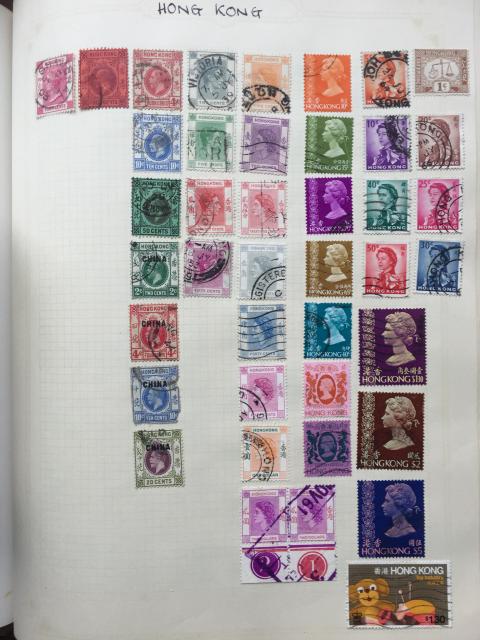One of the results of lockdown in the UK was to encourage me to get my childhood stamp collection out of the loft. I must have put it in its present order at a later bored stage in my life. Others will have much more distinguished collections. As my parents had no correspondents in Hong Kong that I know about, friends must have given me these stamps. Perhaps they had inherited some from grandparents. I gather that the stamps overprinted “CHINA” originated from one of the treaty ports. All comments welcome.
Get Gwulo's books
Directory
Click on your area of interest to choose from over 30,000 pages about old Hong Kong:
- Images & photos
- View - View galleries - View new - Create - Forum topics
- View - Create - Places & buildings
- View map - View new - Create - Streets
- View map - View new - Create - People
- View - View new - Create - Organisations
- View all - View new - Create - Diaries & memoirs
- View - View new - Create diary - Create page - Events
- View - View new - Create - Jurors lists
- View - Type a page
Or choose a popular article:



Comments
Re: Stamp Collection
I note the stamp of Queen Victoria was sent from Shanghai on 21 July 1903. It is mentioned here that "Hong Kong stamps were used in all the post offices that Britain opened in the different ports. In 1917, the design of the stamps included an overprint of the word CHINA."
The 'CHINA' overprint was
The 'CHINA' overprint was used on the Hong Kong KGV definitive adhesives after 1st Janaury 1917 in the British Treaty Ports of China. These were:
Amoy
Canton
Cheefoo
Foochow
Hankow
Hoihow
Ningpo
Shanghai
Swatow
Tientsin
Wei-hai-wei (1 post office each on Liu Kung Tau and Port Edward)
The Multiple Crown CA watermark was used from 1917 to 1922. The second KGV issue with Multiple Script Crown CA was used from 1922 to 1930. You can easily check which watermark it is by holding the adhesive up to a bright light.
All the British Post offices mentioned above were closed on 30th November 1922 except for the leased territory of Wei-hai-wei, which closed on 1st October 1930.
In your collection Jill the cancel on the 2c green is only a partial strike showing '..BR P.O..." within the circular date stamp (c.d.s). The BR PO stands for "British Post Office" I can make an educated guess as to which treaty port it came from but from a collector's POV, a strike showing all the information (index letter or time, day, month, year, name of Treaty Port) is much more desirable and valuable. It's diffucult to achieve that on a small adhesive but that is achieved in your lone Queen Victoria 4c carmine example in your collection. I recognise the cancels on the 4c carmine and 10c pale blue are from Shanghai even though they are partial strikes. The cds on the 20c is too smudged to be identified.
The only thing worth pointing out is that the cancellation on the 4c carmine has the month and year as 'Nov 22'. We are just missing the actual day due to the nature of the partial strike. If it was the 30th, it would be the last day of use (!!!) and that would add much value to the adhesive. The fact that the cancel looks smudged and at an angle would suggest it was actually used postally (genuinely used for the purpose of posting mail), rather than the crisp clean upright cancels that were cancelled to order (ie. 'philatelic cancels') done for collectors (you have first day cancels, and you can have last day cancels).
NB Adhesive = stamp in common parlance. Some philatelists use the term 'stamp' for the actual postmark cancellation on the stamp. So to avoid confusion I always refer to stamps as adhesives.
I am never a fan of sticking (mounting) adhesives (stamps) onto pages of an album (God forbid if it was a mint (unused stamp)!!!).
"Stuck-in" stamps
I feared to be embarrassed by my page of Hong Kong stamps and am grateful for this expert analysis. I imagine that thousands of children like me received a present of a printed stamp album - a page per country with black and white images of two representative stamps. My "equipment" was a philatelic magnifying glass, philatelic tweezers and a green tin of stamp hinges with a black underside for viewing watermarks (thank you, Daddy). I suspect this last branded item might be more of a collector's piece than any of my stamps. A later present of a Stanley Gibbons catalogue (1957?) was the culminating joy.
Sad about the near miss of my 4c carmine. I always hoped that I could rely on my stamp collection to dig me out of a financial hole. I suspect that many of the pre-Elizabeth II stamps are from the same source - gift of a friend - and perhaps quite a few of those were posted on letters from Shangai. Only later did I learn that it was anathema to philatelists to stick stamps in an album. And yes, I have once committed the sin of sticking in mint stamps - only a couple, but a shame nevertheless. I also became aware that you should leave the stamp on the envelope in order to preserve the full postmark (strike).
To my stamps I probably owe more geographic knowledge than to my early geography teachers. They remain fascinating curiosities, if not my path to wealth....